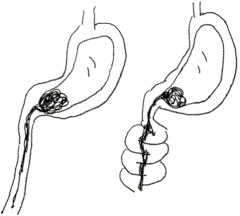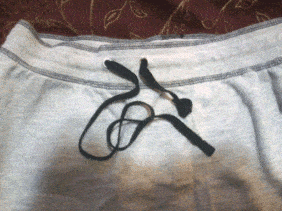Pets eat non-food things they shouldn’t such as toys, socks, rocks and more. One of the worst types of foreign bodies that a pet can have is a string – left untreated, the consequences are grave.
Animals like to play with things and play often involves chewing. Chewing leads to accidental swallowing and from there potential disaster can ensue. Pets of any age will play with toys although it’s more prevalent in the young ones. Common foreign bodies include:
- Corn cobs
- Balls
- Socks and underwear
- Rocks

- Jewelry
- Toys
- Leashes and collars
- Plastic bags (especially if there has been food inside)
- Pieces of shoes
- Coins (pennies are especially dangerous)
- Sewing needles
- Fish hooks.
The list goes on. Playing escalates to chewing, which escalates to swallowing, or the object may be outright mistaken for food and swallowed. Often these objects will pass out the other end in a day or two, though it is possible for a small object to rattle around inside the stomach without passing for weeks. If the object does not pass and causes obstruction or partial obstruction, surgery will be needed to remove it. Prompt diagnosis allows for prompt removal of the foreign body before the bowel is badly damaged. In more advanced situations, sections of damaged bowel must be removed and in the worst possible scenario, the intestine breaks open and spills bacteria and digested food throughout the abdomen. This latter possibility is associated with very high mortality and is to be avoided at all costs.
The foreign body patient develops a poor appetite and vomiting fairly quickly. Listlessness comes soon after. Pain may be difficult to recognize and may simply appear as listlessness. The sooner the patient is evaluated by the doctor, the better.
The Linear Foreign Body is a Special Situation
As if all this wasn’t bad enough, there is an especially bad foreign body situation when the object is a string or similar linear structure. Common linear foreign bodies might include string or yarn (especially for kittens) or a towel or cloth leash where the fabric has not been completely chewed through and long threads are exposed.
The Drawstring Effect
Imagine a drawstring bag or pair of pants. Tie a knot in one end of the drawstring so that it cannot move and pull on the other end. The fabric wads up along the string channel. If the string is pulled hard enough and the knot still will not budge, the string will actually rip right through the string channel.
This is what happens in the linear foreign body scenario. The foreign body lodges somewhere in the GI tract and will not move. The strings, however, dangle forward in the GI tract like a drawstring. The intestine attempts to move them forward but because the foreign body is lodged, the bowel ends up inching up the strings similar to the drawstring channel on the pants. This type of folding upon itself is called “plication” and is the hallmark of the linear foreign body. If the foreign body is not removed, the strings will cut through the intestine leading to life-threatening peritonitis.
String under the Tongue
The first common linear foreign body scenario involves a loop of string wrapped around the base of the tongue. The pet is chewing on a wad of string, the string gets tangled and loops are formed, one of the loops lassos the tongue and the rest is swallowed. The string dangles down the esophagus, passes through the stomach and into the intestine (bowel). The bowel attempts to pass the wad of string but it only gets so far. The string around the tongue becomes taut and the stomach and bowel are sliced open by the tight string.
 The usual victim of the tongue linear foreign body is a cat as cats commonly play with strings. Veterinarians check under the tongue for strings when examining vomiting patients. The string can be difficult to see, especially as many patients are not cooperative about this sort of examination, and the string may have embedded in the base of the tongue where it is not easy to see. Sedation may be needed to get a good look.
The usual victim of the tongue linear foreign body is a cat as cats commonly play with strings. Veterinarians check under the tongue for strings when examining vomiting patients. The string can be difficult to see, especially as many patients are not cooperative about this sort of examination, and the string may have embedded in the base of the tongue where it is not easy to see. Sedation may be needed to get a good look.
Stomach Foreign Body
The other area where linear foreign bodies lodge is the bottom (pylorus) of the stomach. The stomach has a large storage capacity but all of its contents must ultimately drain out of the pylorus. If a wad of cloth is too big to pass but long strings dangle forward from its main body, the intestine will pull at the string, plicating around the string, until the tight string simply cuts through.
Diagnosis of Linear Foreign Body
The linear foreign body is particularly difficult to diagnose. Strings are too small to see on radiographs and cloth does not show up on radiographs. Checking under the tongue for a string is important but not always possible, and even if a string is there it is not always visible. Ultrasound can be more sensitive at seeing linear foreign bodies. But in a vomiting patient that isn’t improving with medical management, sometimes an exploratory surgery is needed to determine the underlying cause should it not be found through x-rays and /or ultrasound.
radiographs and cloth does not show up on radiographs. Checking under the tongue for a string is important but not always possible, and even if a string is there it is not always visible. Ultrasound can be more sensitive at seeing linear foreign bodies. But in a vomiting patient that isn’t improving with medical management, sometimes an exploratory surgery is needed to determine the underlying cause should it not be found through x-rays and /or ultrasound.
Surgery
Because of the dire consequences of not doing surgery when it is needed, it is often best to opt for surgery earlier rather than later in the evaluation process. The patient will need to be rehydrated from past vomiting prior to surgery and stabilized. After this exploration may proceed.
Most likely the foreign body will be obvious in the stomach and can be removed at least in part from the stomach directly. Hopefully, doing this will relieve the plication and the rest of the foreign body can be removed from an intestinal incision. If the bowel is damaged or even perforated, sections of bowel may require removal. After surgery, several days in the hospital may be needed for recovery. If there is going to be a problem with an intestinal incision, it is usually seen by the third day after surgery.
The linear foreign body surgery is generally considered a higher mortality situation than those of more simple foreign bodies.



